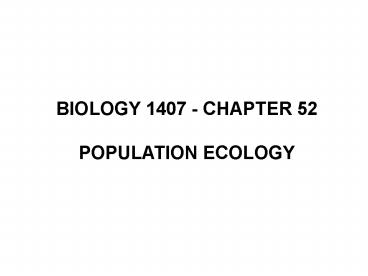BIOLOGY 1407 CHAPTER 52 - PowerPoint PPT Presentation
1 / 41
Title:
BIOLOGY 1407 CHAPTER 52
Description:
N = (Number Marked) X (Catch Second Time) Number Of Marked Recaptures ... Weather - Hot, Cold, Dry. Extremes. Natural in Many Species. Mixed Density Dependent and ... – PowerPoint PPT presentation
Number of Views:53
Avg rating:3.0/5.0
Title: BIOLOGY 1407 CHAPTER 52
1
BIOLOGY 1407 - CHAPTER 52 POPULATION ECOLOGY
2
Figure 52.0 Monarch butterflies
3
POPULATION ECOLOGY
- Population Ecology
- Population
- Population Characteristics
- Population Dynamics
4
Population Dynamics
- Characteristics of Dynamics
- Size
- Density
- Dispersal
- Immigration
- Emigration
- Births
- Deaths
- Survivorship
5
MEASURING DENSITY
Density Number of individuals per unit of
area.
- Determination of Density
- Counting Individuals
- Estimates By Counting Individuals
- Estimates By Indirect Indicators
- Mark-recapture Method
- N (Number Marked) X (Catch Second Time)
- Number Of Marked Recaptures
6
PATTERN OF DISPERSION
RANDOM
UNIFORM
CLUMPED
7
Clumped Dispersion
8
Uniform and Random Dispersion
Random
Uniform
9
DEMOGRAPHY
- The study of the vital statistics of a population
and how they change over time. Factors that
influence population density and dispersion - patterns.
- The Birth And Death Rates Of A
- Population. (Vital Statistics)
- Age Structure - Relative Number Of
Individuals Of Each Age In The Population. - Generation Time
- Sex Ratio
10
LIFE TABLES
Life Tables Age specific summary of the
survival pattern of a population. Describe how
birth rates and death rates vary with age over
A time period corresponding to the maximum
life span. Look at cohorts, a group of
individuals of the same age.
11
SURVIVORSHIP CURVES
Plots the number or percentage of a
cohort alive at each age.
Plot Of The Numbers In A Cohort Still Alive At
Each Age. Type I Type II Type III
12
Survivorship Data for Male and Female Beldings
Ground Squirrel
13
SURVIVORSHIP CURVES
14
LIFE HISTORY
- The traits that affect an organisms
- schedule of reproduction and death.
- Semelparity One large reproductive effort.
- Often found in harsh, unfavorable
environments. - Interoparity Repeated reproductive efforts.
- More common in more stable, more favorable
environments. - Trade-offs and Life Histories
15
Semelparity
Harsh, unpredictable environment.
16
Factors That Influence Life Histories Trade
offs
- Allocation Of Limited Resources
- Cost of Parental Care
- Benefits of Parental Care
- Size of Propagule (Reproductive unit) and
Number Produced - Age Of First Reproduction
17
Many vs. Few
Many very small seed.
A few very large seed
18
POPULATION GROWTH
Intrinsic rate of increase - maximum
population growth that occurs under ideal
conditions with unlimited resources. Change in
population size in a time interval may be
shown as ?N/?t B - D Based on percapita
birth and death rates ?N/?t bN -
mN
19
POPULATION GROWTH RATE
- Exponential Model
- Describes idealized growth rate.
- Describes a growing population that will
double in size. - Equation to describe exponential growth
- dN/dt rmaxN
- 70/Growth Rate Doubling Time
- J SHAPED GROWTH CURVE
20
Growth Prediction From Exponential Model
Two Different rmax Values
21
Example of Exponential Growth
Kruger National Park, South Africa
22
POPULATION GROWTH RATE
LOGISTIC GROWTH RATE Assumes that the rate of
population growth slows as the population size
approaches carrying capacity, leveling to a
constant level. S-shaped curve CARRYING
CAPACITY The maximum sustainable population a
particular environment can support over a long
period of time.
23
Logistic Growth
Equation to describe logistic growth
Where dN growth and dt is time. N is the per
capita rate of increase and K carrying
capacity, thus K-N is the number of additional
individual the environment can accommodate, and
K-N/K is the fraction of k still available for
growth.
24
Population Size/Per Capita Increase
25
Figure 52.11 Population growth predicted by the
logistic model
26
Logistic Models
Stable Population
Seasonal Increase
Severe Environmental Impact
27
POPULATION GROWTH RATE
K -SELECTED POPULATION - EQUILIBRIUM
POPULATION r - SELECTED POPULATION -
OPPORTUNISTIC POPULATION
28
Density Dependent Growth Factors
- Territoriality
- Disease/Health
- Predation
- Competition
- Toxic Waste
- Intrinsic Factors
29
Population DynamicsInteractions Between Biotic
and Abiotic
- Stability And Fluctuations
- Large Animals - Moose
- Small Animals Dungeness Crabs
- Metapopulations and Immigration
- Linked Populations
- Isolated Populations
- Population Cycles
- Lemmings 3-4 Years
- 10 Year Snowshoe Hare/Lynx
30
Large Fluctuations
31
Dungeness Crabs
32
Metapopulations and Immigration
33
Predator/Prey10 Year Cycle
34
Density Independent Factors
- Catastrophes
- Weather - Hot, Cold, Dry
- Extremes
- Natural in Many Species
- Mixed Density Dependent and
- Density Independent Interactions
35
POPULATION CYCLES
HUMAN POPULATION 1650 - 500,000,000 1850 - ONE
BILLION 1930 - TWO BILLION 1975 - FOUR
BILLION 2017 - EIGHT BILLION
36
Human Population Growth
37
Human Growth Rate
38
UNITED STATES POPULATION Age Structure
39
Age Structure Three Countries
40
Infant Mortality/Life Expectancy
41
Global Carrying Capacity
- UN Prediction of 7.5 to 10.3 billion by 2050
- Leeuwenhoek 13.4 Billion - 1679
- Estimates from one trillion to one billion
- Very difficult to predict
- Ecological footprint
- 1.7 Hectares/Person
- Ecological Capacity Footprint to Available
Capacity US 8.4/6.2 ha/person































